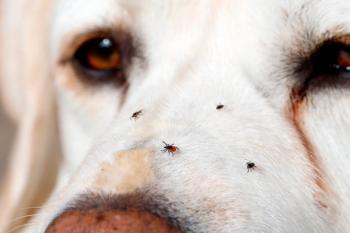
- dvm360 April 2024
- Volume 55
- Issue 4
- Pages: 38
The veterinary profession and its impact on climate change
Veterinary experts discuss how this profession can have an effect on the environment and what you can do to help prevent global warming
Climate change involves long-term changes in temperatures and weather patterns. Certain shifts can be natural, including changes in the sun’s activity or major volcanic eruptions, however, since the 1800s, human activities have been a main contributor of climate change. This is primarily because of the large amounts of burning fossil fuels like coal, oil, and gas. The burning of these fuels releases greenhouse gases that act like a blanket, trapping the sun's heat and causing a rise in temperatures.1
The rise in global surface temperatures has seen a 2º F increase since the 1800s. this might not seem like a huge difference, however Margo Mosher, global sustainability director, Mars Veterinary Health, explains how significant this can really be. In her joint session with Jo Ann Morrison, DVM, MS, DACVIM (SAIM), director of veterinary science at Banfield Pet Hospital, Mosher stated, “Two degrees Fahrenheit may not sound like a lot, but if you think about it similar to the context of our body temperature when you have a fever—so our typical temperature is maybe around 98.6º F, if we increase that just 2 degrees up to 100.6º F, we’re probably not feeling very well. And so, we can think of this similarly with climate change and really the significant impact that just a couple of degree change can have.”2
Therefore, when the earth temperature rises, the following could be at crucial risk:3
- Biodiversity loss
- Drought
- Food security
- Wildfires
- Extreme heat
- Sea level rise
- Floods
- Coral reef decline
What is veterinary medicine’s impact?
The world’s healthcare systems account for 4% of all greenhouse gas emissions, and veterinary medicine is a portion of that 4%.4 Providing care for pet patients has a carbon footprint from using electricity, anesthesia, medical supplies, and even veterinary professionals and pet owners driving to the clinic. According to IVC Evidencia, a European veterinary care provider, medical supply and pharmaceutical purchases used for veterinary practices is one of the leading contributors to the veterinary carbon footprint.5 This is the area in which veterinary professionals can have the most impact in reducing their carbon footprint.
What you can do
- Conference travel: Dr Morrison explained how commuting to work and travel for conferences can add to a veterinary professional’s carbon footprint. She suggested attending virtual meetings, however, “If an in-person meeting is necessary, then is there a more sustainable option, rather than flying? Is there an option for things like rail or train travel or electronic vehicles? If flying is necessary, what are the most sustainable options to consider here? There’s direct versus connecting flights, and these have different carbon footprints.”
- Work commute: Morrison also posed the option of taking public transportation to work if that is a viable option. However, she did mention that this can also be a personal choice for each individual. “The first thing to do is have some discussions with your teams. Investigate what is available in your area and see what people would consider in changing with commuting to the practice…maybe there is a fun or creative way to encourage biking to work—again, in areas where that is feasible and that will vary from place to place,” she said.
- Virtual care: Offering telehealth can also offset clients commuting to the clinic. This can be beneficial even if just a portion of appointments can switch to an online format. Telehealth can also reduce the use of medical supplies, which has a large impact on the overall veterinary footprint.
- Electricity reduction: Another small change practices can make is reminding associates to reduce electricity around the practice when possible. Turning off lights when a room is not in use or unplugging equipment that does not need to be on can be simple efforts made daily.
- Anesthetic gases: Anesthetic gases used for procedures have different environmental impacts. Mosher recommended prioritizing the needs of the patient first, but to consider using lower impact gases, such as sevoflurane, and using lower flow techniques to reduce the impacts anesthesia has on climate change.
- Sustainable purchases: Because medical supplies can be a major contributor to veterinary medicine’s carbon footprint, Mosher suggested selecting suppliers who demonstrate a commitment to sustainability (when possible) and consolidating orders and deliveries.
- Waste management and recycling: Waste management can be tackled by starting with prevention as the most preferred method, and when that is not an option, going down the line of reusing, recycling, recovery, and disposal being the last option remaining if necessary. For veterinary medicine, consider what in your practice that can be eliminated, reused, or recycled. For example, reducing paperwork and going digital with patient records can be an option in preventing waste.
Reaching for a climate friendly future
Mosher and Morrison’s overall advice for reducing your practice’s carbon footprint is to discuss with your team and see what will work within your means. Engage your team and get everyone involved so each member of the team is making a difference. If certain members of your team are more passionate about climate change than others, let them take some of the lead and lean into their personal interests in improving the practice’s efforts. Celebrating small wins in the progression and becoming more sustainable is also important to recognize on this climate journey. Combating climate change is a collaborative endeavor.
Before wrapping up, Mosher shared a way to calculate your practice’s carbon footprint by using the “CoolClimate Network” website powered by the University of California, Berkeley. This can also share more tips for reducing your footprint. If interested, veterinary professionals can also access resources on Banfield or Mars Veterinary Health’s website.
References
- What is climate change? United Nations. Accessed January 25, 2024.
https://www.un.org/en/climatechange/what-is-climate-change - Mosher M, Morrison JA. Climate change and the veterinary profession. Presented at: Veterinary Meeting & Expo; Orlando, Florida; January 13-17, 2024.
- Climate change: 5 charts from the IPCC report that show why every increment of warming matters. World Economic Forum. March 23, 2023. Accessed January 25, 2024.
https://www.weforum.org/agenda/2023/03/climate-change-ipcc-emissions-risks-net-zero/ - Protecting the planet and its people: healthcare's climate action roadmap. World Economic Forum. June 2, 2021. Accessed January 25, 2024.
https://www.weforum.org/agenda/2021/06/healthcare-climate-action-roadmap/ - The positive pawprint: Sustainability report 2023. IVC Evidencia. 2023. Accessed January 25, 2024.
https://ivcevidensia.com/getmedia/70832551-51b0-4fd2-9651-b0e2d5eac222/IVC-Evidensia-Sustainability-Report_2023.pdf
Articles in this issue
over 1 year ago
Keeping up with our Kansas City keynote speakersover 1 year ago
There’s so much in store for the graduating class of 2024over 1 year ago
Dirofilaria immitis: The monster then and nowover 1 year ago
Stay competitive—and ethicalover 1 year ago
A new name for “drop-off”over 1 year ago
Striving for equity in veterinary medicineover 1 year ago
The hardest job in a hospital (according to a veterinarian)Newsletter
From exam room tips to practice management insights, get trusted veterinary news delivered straight to your inbox—subscribe to dvm360.






